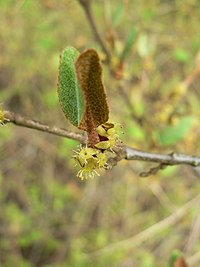Shepherdia canadensis
| Shepherdia canadensis subsp. var. | Canada Buffaloberry, Russet Buffaloberry, Soopolallie, Soapberry, Foamberry | |||||||||||||||||||||||||||||||||||||||||||||||||||||||
|---|---|---|---|---|---|---|---|---|---|---|---|---|---|---|---|---|---|---|---|---|---|---|---|---|---|---|---|---|---|---|---|---|---|---|---|---|---|---|---|---|---|---|---|---|---|---|---|---|---|---|---|---|---|---|---|---|

|
|
| ||||||||||||||||||||||||||||||||||||||||||||||||||||||
| ||||||||||||||||||||||||||||||||||||||||||||||||||||||||
The Canada Buffaloberry (Shepherdia canadensis), also known as Russet Buffaloberry, Soopolallie, Soapberry, or Foamberry, is one of a small number of shrubs of the genus Shepherdia bearing edible red berries. One recognized form however bears yellow fruits. The berries have an extremely bitter taste.
The plant is a deciduous shrub found in open forests and thickets all over North America. Its northern limit is around the Arctic Circle. The shrub reaches a height of 1–4 m (3–13 feet).
Fruits are extensively collected by some Canadian First Nations peoples such as Nlaka'pamux (Thompson), St̓átimc and Secwepemc (Shuswap) in the province of British Columbia. The bitter berries are not eaten directly but rather processed as sxusem ("sxushem") or "Indian ice-cream". Branches bearing fruit are hit with a stick and only the very ripe fruits that fall off are collected. A clean mat or tarpaulin is placed below the bush for collection.
Persons reading about saponins should be forewarned that unrelated plants in the genus Sapindus, which produce highly toxic saponins, share the common name soapberry with the edible Canada Buffaloberry. References to Sapindus "soapberry" toxins should not be misattributed to Canada Buffaloberry.
A decidious Shrub growing to 2.5m at a medium rate.
It is hardy to zone 2 and is not frost tender. It is in flower in April, and the seeds ripen from July to September. The flowers are dioecious (individual flowers are either male or female, but only one sex is to be found on any one plant so both male and female plants must be grown if seed is required)The plant is not self-fertile. It can fix Nitrogen.
| Standard Cyclopedia of Horticulture |
|---|
|
Shepherdia canadensis, Nutt. (Lepargyraea canadensis, Greene). Spreading twiggy bush 3-6 or even 8 ft. tall, the young branches brown-scurfy: lvs. ovate, oval, or elliptic, rather thick, green above but rusty beneath: fls. yellowish, in short clusters at the nodes: fr. small (1/4 in. or less long), oval, red or yellow, insipid. Along streams and on lake-banks, Newfoundland to Brit. Col. and in the northern tier of states, and southward in the mountains to Utah.—The yellow-fruited form has been distinguished as f. xanthocarpa, Rehd. CH
|
Cultivation
The plant prefers light (sandy), medium (loamy) and heavy (clay) soils, requires well-drained soil and can grow in nutritionally poor soil. The plant prefers acid, neutral and basic (alkaline) soils. It can grow in semi-shade (light woodland) or no shade. It requires dry or moist soil and can tolerate drought. The plant can tolerate maritime exposure.
Succeeds in an ordinary well-drained moisture retentive soil[1, 3, 11]. Tolerates poor dry soils[200] and maritime exposure[182]. Established plants are drought resistant[182]. Plants can accumulate mercury when they are grown in polluted soils[172]. Rarely produces fruits in Britain[182]. Some named varieties have been developed for their ornamental value[200]. 'Xanthocarpa' has yellow fruits, 'Rubra' has red fruits[200]. Plants in this genus are notably resistant to honey fungus[200]. This species has a symbiotic relationship with certain soil bacteria, these bacteria form nodules on the roots and fix atmospheric nitrogen. Some of this nitrogen is utilized by the growing plant but some can also be used by other plants growing nearby[200]. Dioecious. Male and female plants must be grown if fruit and seed is required.
Propagation
Seed - it must not be allowed to dry out[113]. It is best harvested in the autumn and sown immediately in a cold frame. Stored seed requires 2 - 3 months cold stratification[113]. Prick out the seedlings into individual pots once they are large enough to handle. If sufficient growth is made it will be possible to plant them out in the summer, otherwise grow them on in a cold frame for their first winter and plant them out in the following spring or early summer. Cuttings of half-ripe wood, July/August in a frame sometimes work[113].
Pests and diseases
Varieties
Gallery
References
- Plants for a Future - creative commons text incorporated
- Standard Cyclopedia of Horticulture, by L. H. Bailey, MacMillan Co., 1963
External links
- w:Shepherdia canadensis. Some of the material on this page may be from Wikipedia, under the Creative Commons license.
- Shepherdia canadensis QR Code (Size 50, 100, 200, 500)
